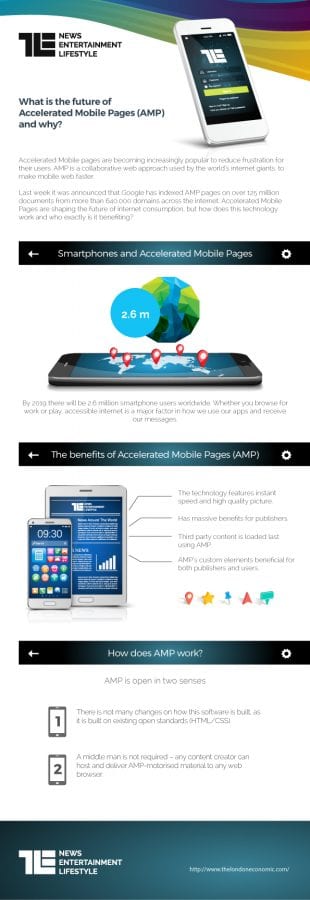[gdlr_styled_box content_color=”#ffffff” background_color=”#444444″ corner_color=”#333333″ ]Brian Lonsdale sheds light on the latest Google initiative AMP (Accelerated Mobile Pages), and tells TheLondonEconomic.com what it means for website owners. Brian is an SEO expert dedicated to increasing client’s website traffic through major search engines for medium to large businesses in the UK. Visit https://www.
smarterdigitalmarketing.co.uk to find out how you can benefit.[/gdlr_styled_box]
Last week it was announced that Google has indexed AMP pages on over 125 million documents from more than 640,000 domains across the internet. Accelerated Mobile Pages are shaping the future of internet consumption, but how does this technology work and who exactly is it benefiting?
Smartphones and Accelerated Mobile Pages
 Richard Gingras (Head of News, Google) states that “the Success of the AMP project isn’t going to be based on the leadership of one, it’s going to be based on the leadership of many”. Over the past few months, the AMP badge has started appearing on our mobile screens under some of the world’s biggest search results, but why should we trust it?
Richard Gingras (Head of News, Google) states that “the Success of the AMP project isn’t going to be based on the leadership of one, it’s going to be based on the leadership of many”. Over the past few months, the AMP badge has started appearing on our mobile screens under some of the world’s biggest search results, but why should we trust it?
Launched in late 2015, AMP was envisioned collectively by Google and dozens of other publishers and technology companies. Millions of us access the internet via our smartphones forcing these organisations to sit down together to figure out a solution to slow mobile internet practices.
By 2019 there will be 2.6 million smartphone users worldwide. Whether you browse for work or play, accessible internet is a major factor in how we use our apps and receive our messages. When Apple launched the very first iPhone nearly ten years ago, they promised to is reinvent the way we used our phones, giving users a desktop class experience on a mobile platform.
What are the benefits of Accelerated Mobile Pages (AMP)?
With publishers such as The Economist and The Financial Times involved, as well as big social media players like Twitter and LinkedIn, it means that many of us will reap the benefits of Accelerated Mobile Pages.
Users become frustrated with non-accelerated web pages because they are it may take a long time for the page to load. Melissa Bell, co-founder of Vox an internet blogging service, claims that AMP will be the method in which we “tell the best stories”. The benefits of an AMP page are extremely visible from first glance, and the technology features instant speed and high quality picture.
Of course, it is not just users experience which will be improved, this technology has massive benefits for publishers. If content providers are losing readers who are not willing to wait for content and ads, effectively their business will be damaged by advertisers dropping because of heavy bounce rates.
AMP displays that the solution to this is simple. Third party content is loaded last using AMP meaning that readers can start reading material on the page before the graphics and ads load up!
Noemi Ramirez, Chief Digital Officer at EL PAIS, the highest-circulation daily newspaper in Spain believes that “more people will see us, more people will see our ads, more people will read our content” if your site uses AMP. Making AMP’s custom elements beneficial for both publishers and users.
Why change to Accelerated Mobile Pages?
As AMP’s main focus is on the consumer experience and content accessibility it means that third party content is loaded last. When using AMP users receive clear and quick results and in turn bounce rates will reduce.
Paul Maiorana, Vice President of Platform Services at WordPress, is also backing the project promising that there is no gatekeeper between the publisher and its audience.
How does AMP work?
So how does this open source project work? AMP is open in two senses; firstly, there is not many changes on how this software is built, as it is built on existing open standards (HTML/CSS). Secondly, a middle man is not required – any content creator can host and deliver AMP-motorised material to any web browser.
AMP also prioritises your load chain, giving readers what they want first and what your organisation needs advertising or promotional wise second– giving everyone what they want in the most efficient order.
AMP HTML has been created to be a s simple as possible for web developers – it is HTML with just some restrictions for consistent performance with added extensions for building richer content.
Google breakdown the AMP method metaphorically stating that content is king and user experience is queen. The AMP JS library is an advanced loading system ensuring the fast rendering of AMP HTML pages before anything else.
Features of Accelerated Mobile Pages
Google recently announced a new AMP error reporting feature within Google Search Console. This feature helps webmasters install AMP across their websites.
This report gives users an indication of the overall situation of their site, and highlights what to fix in specific error types and URLs. This process enables users to efficiently establish their websites most common issues, so that they can then address them in your site’s AMP implementation.
The Future of Accelerated Mobile Pages
We are only now seeing AMP come to life, daily users of social media will soon be programmed to the way AMP works and its high speed, user first experience will become a standard.
If you are a content provider that receives a large portion of your traffic through google inbound traffic, we suggest that your move towards AMP HTML, quickly.
The other option is to wait it out and see how the AMP project progresses over time before testing it on your website. With strong backers like WordPress to the social media giants like LinkedIn and Twitter – web designers and developers need to understand this promising technology before they put their time into it.
What’s Next for AMP?
Richard Gingras and his team at Google want to “make the web great again” and this project in particular seems to be a positive one – for publishers, platforms and developers. Gingras that they are taking further steps with the project and announced last week that AMP is planning to expand onto iOS & Android apps and recipe pages.
There is potential for a conflict of interest with AMP, as AMP sites may become more favourable search results and Google applications such as Google Analytics may be needed to monitor some aspects of the technology.
Nonetheless consumers will soon come to expect the high speed standards of AMP, and as a result of this, be prepared for more new performance innovation and improvements to current mobile sites.
Competition can be harmless and as long as the internet’s biggest players are providing accessibility and speed everyone is happy – right?
Featured image by Tony Webster – Own work, CC BY-SA 4.0, https://commons.wikimedia.org/w/index.php?curid=37675044


